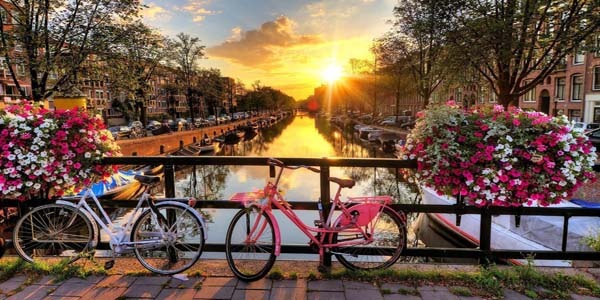Barcelona is a charming seaside town where Gaudí’s visionary imprint blends with Roman ruins and the charm of Gothic architecture.
Wandering what to see in Barcelona? This is the city where you can immerse yourself in the dreamlike world of the master of Modernism, discover the places that inspired Catalan artists such as Salvador Dalí, Pablo Picasso and Joan Miró, enjoy the Iberian sun on the most beautiful beaches in Spain and start the evening with a copa de vino tinto, in front of a flamenco show.
The capital of Catalonia is a city that never sleeps. Our travel blog will take you to discover it.
What to see in Barcelona
La Rambla
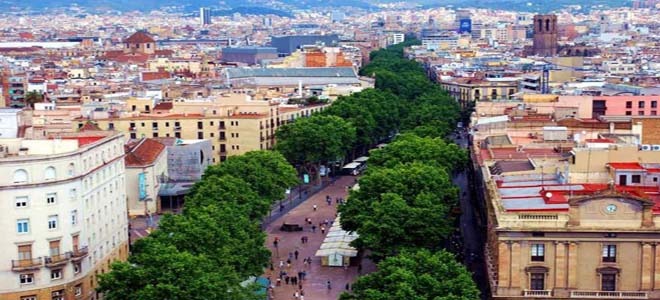
It is the most famous pedestrian boulevard in Barcelona and although it is the most touristy, you can’t miss the walk along the Rambla which stretches for 1.2 km to the sea. In the shade of the plane trees, Barcelonians and foreigners flock at any time of the day or night, among cafes, restaurants, kiosks, newsstands, street artists, musicians, mimes and living statues on this wide pedestrian street. You won’t get bored walking on the Rambla.
Read also: Best places to visit in Liverpool
Besides the human river, if you look up, on the sides of the avenue you will see some of the iconic places of Barcelona, such as the Gran Teatre del Liceu, the Mercat de la Boqueria, a large mosaic of Miró and several art galleries. La Rambla is divided into five sections, which is why you will have heard of Las Ramblas in the plural.
La Sagrada Familia
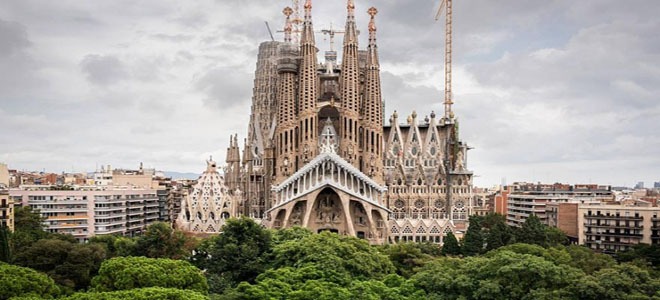
In Barcelona you will see the last modernist masterpiece by Antoni Gaudí, still unfinished more than a century after the construction began. Spectacular, solemn, the temple of Barcelona in Gothic style soars upwards like the medieval cathedrals from which it takes its inspiration, arousing an alienating effect in the visitor, just like Gaudi’s other works. The Catalan architect’s project foresaw a temple 95 m long and 60 m wide in which 13,000 people could sit, with 12 towers along the facades.
Despite the interruptions and diatribes that have alternated over time, the work is expected to be completed between 2026 and 2028. Once you have overcome the initial astonishment, therefore, go through the sculpted portals, and immerse yourself in a forest of columns that branch out towards the ceiling and among the light reflections of the stained glass windows. Notice the endless wrought-iron details and the countless symbols scattered around the basilica.
The Sagrada Família has three facades: the Nativity Façade, built largely under the supervision of Gaudi, the Passion Façade, which traces the last days of Christ and his death, and the Glory Façade, designed by Gaudi as the most beautiful facade that will represent the microcosm of the Christian Church when it is finished.
If you do not suffer from vertigo and have no breathing problems, you could climb one of the towers of the facade of the Nativity through the elevators or the narrow spiral staircase. Finally, in a basement, you’ll find the Gaudi Museum, which recounts the talent of the Catalan genius, buried here in a crypt that you can visit by entering from the side of the church overlooking Carrer de Mallorca.
Parc Guëll

The entrepreneur Eusebi Güell commissioned Gaudí to design a miniature town with prestigious houses surrounded by landscaped gardens. The result was a visionary world later declared a UNESCO World Heritage Site. The Parc Guëll saw the light of day in 1900.
You will recognize the entrance by the iron door but above all by the two fairy-tale buildings, the access staircase is then guarded by a salamander covered with mosaics and you will arrive at the Hipóstila Hall, also known as the Doric Temple, a forest of 88 stone columns. In the park you’ll also find Gaudí’s Casa-Museu, but above all, don’t miss the Banc de Trencadís, a very long bench covered in tiled mosaics with curved lines that runs around the perimeter of the belvedere from which you can admire all of what you want to see in Barcelona.
La Pedrera

It is another masterpiece by Gaudí, created between 1905 and 1910 with the intention of surpassing any other palace in Eixample in beauty and extravagance. Overlooking the elegant Passeig de Gràcia, this curvilinear creature officially called Casa Milà, after the client, is better known as La Pedrera (stone quarry) for its irregular grey stone façade. From the outside, La Pedrera already shows the distinctive signs of Gaudí: the undulating façade like a cliff, the surreal wrought-iron balconies and the catenary arches similar to cave entrances.
Read also: How to visit Socotra, Yemen
The soft curves and surprising details also chase each other in the interior. Visit, then, El Pis de la Pedrera, the main apartment, which will give you an idea of how a Catalan upper middle-class family lived in the early 20th century. Don’t miss the roof where bizarre chimneys that look like medieval knights stand out. The roof is also an enchanting setting for summer concerts.
Batlló House
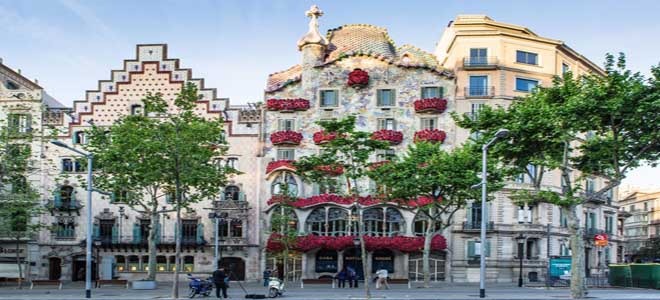
The work of Gaudí’s visionary genius is what to see in Barcelona. Casa Batlló is certainly one of the most eccentric residential buildings in Europe. Gaudí was commissioned to renovate this building on Passeig de Gràcia, which you will recognise by its façade studded with blue, mauve and green tiles, small balconies and undulating cornices, surmounted by an irregular roof covered with blue tiles and a solitary tower.
Gaudí did not like straight lines, so Casa Batlló is also a whirlwind of soft curves, spirals and dreamlike shapes between coloured glass and the infinite shades of sea blue. Casa Batlló is also called the “house of bones” or “house of the dragon”, because the balconies look like skulls and the roof represents Saint George winning the dragon. Finally, Casa Batlló together with the nearby Casa Amatller and Casa Lleó Morera, forms the so-called Manzana de la Discordia, the apple of discord, because they compete for the title of the most beautiful house. In any case, this is where the best of modernist eclecticism is concentrated.
Fundació Joan Miró
Joan Miró, a revolutionary and proudly Catalan artist, donated this foundation to Barcelona, his hometown, in 1971. Designed by his friend and architect Josep Lluís Sert, the luminous complex of buildings that houses the Fundació Joan Miró is surrounded by the greenery of the Montjuïc hill. The foundation boasts the largest monographic collection of Miró’s works.
Read also: Best places to visit in Colombia
Some 220 paintings, 180 sculptures and over 8000 drawings provide an enlightening portrait of Miró and his art, although only a small part of these works is on public display. Going out on the eastern side of the foundation you will find the Jardí de les escultures, a garden where you can relax in the shade of the many modern sculptures.
Picasso Museum
The Picasso Museum is located in five medieval stone buildings in the Ribera district that are already worth a visit. If you then think that between courtyards, galleries and stairways follow one another the works of Picasso, you will understand why this museum is unique. The collection is mainly dedicated to the formative years of Picasso, who was born in Malaga and lived in Barcelona from the age of 15 to 23.
Among the masterpieces not to be missed is definitely Las Meninas. To get your bearings, remember that the permanent collection is displayed in the 14th century setting of the Palau Aguilar, Palau del Baró de Castellet and Palau Meca, while the Casa Mauri and Palau Finestres host permanent exhibitions.
Museu Nacional d’Art de Catalonia
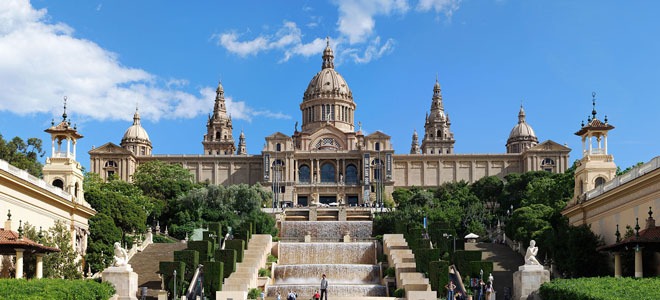
The monumental neo-Baroque architecture of the Palau Nacional, built on the slopes of Montjuïc for the International Exhibition of 1929, houses the Museu Nacional d’Art de Catalonia. Here is an impressive collection that ranges from the High Middle Ages to the beginning of the 20th century, retracing a thousand years of artistic production in Catalonia that is a world apart from the rest of Spain.
Read also: How to become a travel blogger
Don’t miss the section dedicated to Romanesque art with frescoes, large altarpieces and wood carvings saved from ruined churches in the Pyrenees. However, the collections on display at the museum represent around 20% of the museum’s entire heritage. So if you don’t know what to see in Barcelona, join a guided tour of the warehouses for 5 euros.
Església de Santa Maria del Mar
Built in the 14th century on Passeig del Born, the Església de Santa Maria del Mar is the most beautiful Gothic church in Barcelona, characterized by a lighter decoration than the Gothic churches of Northern Europe. Erected in just 54 years, a record time for the time, the church is interesting for its architectural harmony and for having survived the civil war. If from the outside the church looks severe, the inside will surprise you with its spaciousness and brightness. If you are lucky, you could attend a concert of classical music, often baroque.
The Cathedral
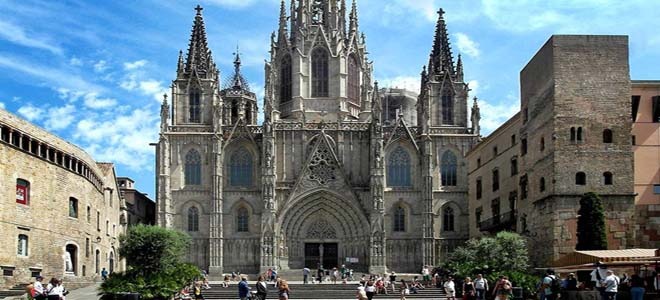
A Catalan Gothic masterpiece, Barcelona Cathedral impresses with its façade richly decorated with friezes and stone gargoyles. Walking through the side chapels inside illuminated by the light filtered through the stained glass windows, you reach the staircase in front of the high altar that leads to the crypt where the tomb of Santa Eulàlia, the patron saint of Barcelona, is kept.
Read also: Best places to visit in Germany
Then go out into the cloister where 13 geese still live today, as many as there were at the time of Santa Eulàlia’s martyrdom. Since the Middle Ages the geese squawk in the silence of the cloister. Finally, the cathedral is a stop not to be missed on your tour of the Ciutat Vella, also because, according to medieval tradition, something always happens on the cathedral square. From the dance of the sardine to the processions linked to some recurrence, the square always hosts open-air markets and street musicians.
Palau de la Música Catalana
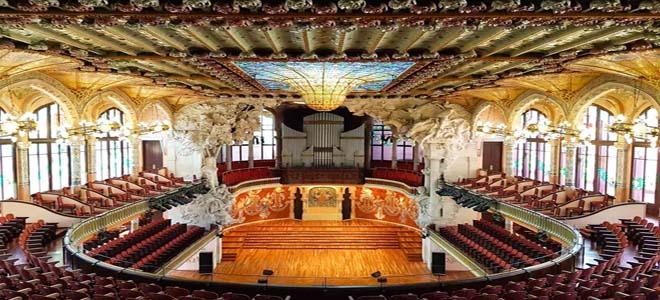
It is the temple of music designed in perfect modernist style by Domènech i Montaner at the beginning of the 20th century. The Palau de la Música Catalana is a riot of tiles, sculpted stone and stained glass windows that can already be seen in the splendour of its façade. After having seen the foyer and the restaurant, climb up to the auditorium which, surmounted by a glass skylight, shines amidst blue and golden gleams. To visit it, you can attend a concert or take part in a guided tour.
Mercat de la Boqueria
It is one of the largest food markets in Europe. It is the market where the inhabitants of the area have been going shopping since 1217, although today it has almost become a tourist attraction. The Mercat de la Boqueria is an explosion of scents, sounds and colours where you can meet housewives but also restaurant chefs.
If you get hungry, at the bottom of the market you’ll find tapas bars, unfortunately often crowded, where you can taste Catalan specialities such as bacallà salat (stockfish), calçots (grilled onions), cargols (snails), peus de porc (pig’s feet) and percebes (shellfish served with a garlic and parsley sauce).
Camp Nou
The huge Camp Nou stadium where the legendary Football Club Barcelona plays is one of the best travel destinations for football fans and more. Attending a FC Barcelona match is always an exciting experience. Otherwise take a guided tour of the stadium from the locker rooms, through the tunnel to the pitch and into the presidential grandstand. In the end even the less experienced footballers will know all about the champions who played in Barça, such as Maradona, Ronaldinho and Kubala.
Tibidado
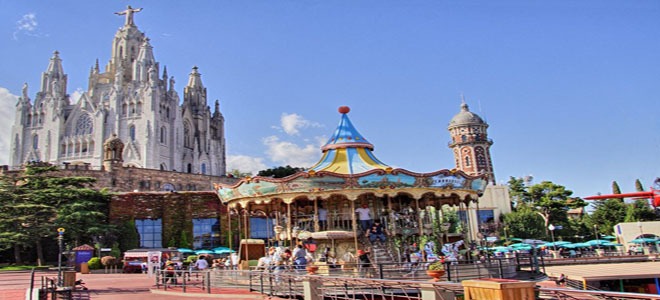
Don’t miss the climb to Tibidabo, a mountain close to the centre of Barcelona, there are the Church of San Giovanni Bosco and the oldest amusement park in Spain (and the second in Europe) called Tibidabo, like the mountain. From up here the view of the city is spectacular.
Bellesguard Tower
Torre Bellesguard is one of Gaudi’s least famous and best known works, yet incredibly beautiful, both inside and out. On torrebellesguardgaudì you can find all the info to visit the most exclusive building of the Catalan artist. It is closed every Sunday.
Modernist Fences of San Pau
The Hospital de Sant Pau is the old hospital to see in Barcelona and is also the largest modernist complex in Europe. The architect is Domènich i Montener who built a real city within the city. Today it houses a museum and you can visit the main pavilions where the rooms of the sick and some rooms as they were in the 20s of the last century have been rebuilt.
Casa Vicens
In the heart of the Gracia district in Barcelona, Casa Vicens is the first work created by Antoni Gaudi, a work known as The house where it all began. The result was the creation of a fairytale house that is a mix of styles and genres that already reveal the genius of the artist.
Labyrinth Park of Horta
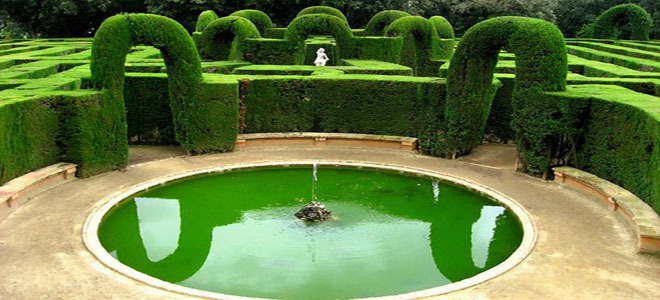
The Horta Maze Park is the oldest park to visit in Barcelona and is famous for its intricate maze of cypresses and hedges of spires. In addition to the labyrinth, however, there are colours, a nymphaeum, a grotto and the boxwood garden, populated by anmali sculptures that children love so much.
What to see in Barcelona in two or three days
- La Rambla
- La Sagrada Família
- Casa Batlló
- La Pedrera
- Parc Guëll
- Fundació Joan Miró
- Museu Picasso
- Museu Nacional d’Art de Catalonia
- Església de Santa Maria del Mar
- La Catedral
- Palau de la Música Catalana
- Mercat de la Boqueria
- Ciutat Vella
- Barri Gòtic
- Gràcia
- Barceloneta
- Montjuïc
- Eixample
- Camp Nou
What to see in Barcelona with children
If you are in Barcelona with your young children, you could certainly take them to Rambla where they will be ecstatic in front of mimes, living statues and street artists. But you could also visit the curious and dreamlike world of Gaudí, between Parc Guëll, La Pedrera and Casa Batlló.
What to see in Barcelona among the museums? You might have more fun at the Maritime Museum or the Chocolate Museum than at the Fundació Joan Miró. Relax between the zoo, pond and playground in the Parc de la Ciutadella. Finally, no child will ever say no to a ride on the funicular. Then take the Transbordador Aeri from Barceloneta beach to Montjuïc mountain. And above all, try to arrive in time for the Magic Fountain of Plaça Espanya, a show of water, lights and sounds that repeats itself at sunset at different times depending on the season.
Where to eat in Barcelona
For a quick lunch or an aperitif do as the Barcelonians do, stop at one of the many tapas bars where you can choose an assortment of saucers of the best Catalan specialties, to accompany a beer or a glass of wine.
Of course, don’t stop for any reason to eat at the tourist spots on Las Ramblas. If you are looking for an authentic restaurant where you can find local people, go to El Born, La Barceloneta, El Raval and Gràcia. And remember that, as in all of Spain, you sit down to eat late. Lunch is between 2pm and 4pm, dinner is around 10pm.
Where to sleep in Barcelona
If you want to spend little but don’t like hostels, book one of the many hostels or pensions in Barcelona, small family-run facilities on the Rambla, in the back streets of the Gothic Quarter, El Raval and in the Plaça Reial area.
In the centre, however, you will find all kinds of accommodation, from Airbnb apartments to the most luxurious hotels. Remember to book in advance if you visit Barcelona in high season, from March to September. Between October and March, however, hotels offer special rates and promotions. If you are looking for the coolest neighborhood, here you will find a nice selection.
Surroundings of Barcelona
If you have time to explore the surroundings of Barcelona, here are several destinations easily accessible by car or public transport.
Guell Cologne
Half an hour north of Barcelona, hidden between the villages of Santa Coloma de Cervelló and Sant Boi de Llobregat, is Colonia Güell, a workers’ village built to house avant-garde textile factories and workers’ families in a sort of utopian city. Colonia Guell was built by Gaudi at the behest of the industrialist Eusebi Güell, the same entrepreneur who gave his name to Parc Guell.
Costa Brava
Blue sea, rocky coves surrounded by greenery, charming villages. The easiest destinations to reach, but also the most touristy, are Lloret de Mar and Tossa de Mar, but we recommend you rent a car and visit wonderful and much more authentic villages such as Cadaques, Palamos, Calella de Palafrugell, Pals and Begur.
Sitges
Pretty gay-friendly town along the coast where you can visit the Romantic Museum and the Cap Ferrat Museum as well as enjoy the beaches.
Montseny Natural Park
One of the most beautiful natural parks in the surroundings of Barcelona where you can take beautiful walks in the green between small Romanesque style mountain churches like Montseny, El Brull, Sant Marçal, Sant Martí del Montseny and Aiguafreda de Dalt.
Montserrat Monastery
Benedictine monastery at 700 meters above sea level to be reached by the rack train that climbs the mountains.
Girona
They call it Petita Florència because of its pastel-coloured houses reflected in the Onyar River. Take a tour of the Força Vella, the ancient part of the city within the walls.
Tarragona
Visit the Roman amphitheatre and Santa Maria Cathedral before enjoying the sun on the beaches of the Costa Dorada.
Vall de Núria Famous ski resort in the Pyrenees which in summer turns into a wonderful oasis of peace for nature lovers.




